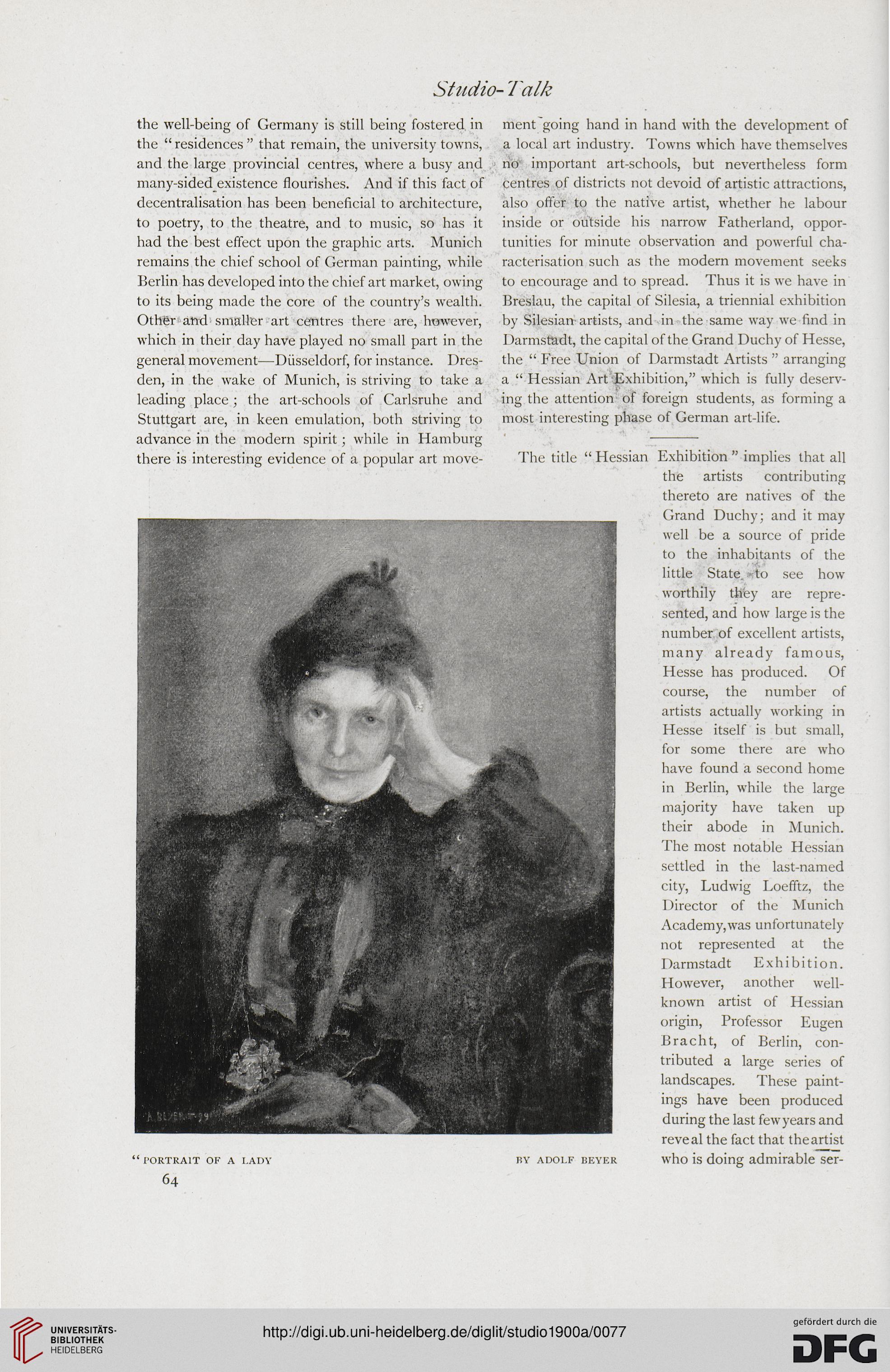Studio-Talk
the well-being of Germany is still being fostered in ment going hand in hand with the development of
the "residences " that remain, the university towns, a local art industry. Towns which have themselves
and the large provincial centres, where a busy and rib" important art-schools, but nevertheless form
many-sidedexistence flourishes. And if this fact of centres of districts not devoid of artistic attractions,
decentralisation has been beneficial to architecture, also offer to the native artist, whether he labour
to poetry, to the theatre, and to music, so has it inside or outside his narrow Fatherland, oppor-
had the best effect upon the graphic arts. Munich tunities for minute observation and powerful cha-
remains the chief school of German painting, while racterisation such as the modern movement seeks
Berlin has developed into the chief art market, owing to encourage and to spread. Thus it is we have in
to its being made the core of the country's wealth. Breslau, the capital of Silesia, a triennial exhibition
Other and smaller art centres there are, however, by Silesian artists, and in the same way we find in
which in their day have played no small part in the Darmstadt, the capital of the Grand Duchy of Hesse,
general movement—Diisseldorf, for instance. Dres- the " Free Union of Darmstadt Artists " arranging
den, in the wake of Munich, is striving to take a a " Hessian Art Exhibition," which is fully deserv-
leading place ; the art-schools of Carlsruhe and ing the attention of foreign students, as forming a
Stuttgart are, in keen emulation, both striving to most interesting phase of German art-life,
advance in the modern spirit; while in Hamburg -
there is interesting evidence of a popular art move- The title " Hessian Exhibition " implies that all
the artists contributing
thereto are natives of the
Grand Duchy; and it may
well be a source of pride
to the inhabitants of the
little State, "to see how
worthily they are repre-
sented, and how large is the
number, of excellent artists,
many already famous,
Hesse has produced. Of
course, the number of
artists actually working in
Hesse itself is but small,
for some there are who
have found a second home
in Berlin, while the large
majority have taken up
their abode in Munich.
The most notable Hessian
settled in the last-named
city, Ludwig Loefftz, the
Director of the Munich
Academy,was unfortunately
not represented at the
Darmstadt Exhibition.
However, another well-
known artist of Hessian
origin, Professor Eugen
Bracht, of Berlin, con-
tributed a large series of
landscapes. These paint-
ings have been produced
during the last fewyears and
reveal the fact that the artist
" portrait of a lady by adolf beyer who is doing admirable ser-
64
the well-being of Germany is still being fostered in ment going hand in hand with the development of
the "residences " that remain, the university towns, a local art industry. Towns which have themselves
and the large provincial centres, where a busy and rib" important art-schools, but nevertheless form
many-sidedexistence flourishes. And if this fact of centres of districts not devoid of artistic attractions,
decentralisation has been beneficial to architecture, also offer to the native artist, whether he labour
to poetry, to the theatre, and to music, so has it inside or outside his narrow Fatherland, oppor-
had the best effect upon the graphic arts. Munich tunities for minute observation and powerful cha-
remains the chief school of German painting, while racterisation such as the modern movement seeks
Berlin has developed into the chief art market, owing to encourage and to spread. Thus it is we have in
to its being made the core of the country's wealth. Breslau, the capital of Silesia, a triennial exhibition
Other and smaller art centres there are, however, by Silesian artists, and in the same way we find in
which in their day have played no small part in the Darmstadt, the capital of the Grand Duchy of Hesse,
general movement—Diisseldorf, for instance. Dres- the " Free Union of Darmstadt Artists " arranging
den, in the wake of Munich, is striving to take a a " Hessian Art Exhibition," which is fully deserv-
leading place ; the art-schools of Carlsruhe and ing the attention of foreign students, as forming a
Stuttgart are, in keen emulation, both striving to most interesting phase of German art-life,
advance in the modern spirit; while in Hamburg -
there is interesting evidence of a popular art move- The title " Hessian Exhibition " implies that all
the artists contributing
thereto are natives of the
Grand Duchy; and it may
well be a source of pride
to the inhabitants of the
little State, "to see how
worthily they are repre-
sented, and how large is the
number, of excellent artists,
many already famous,
Hesse has produced. Of
course, the number of
artists actually working in
Hesse itself is but small,
for some there are who
have found a second home
in Berlin, while the large
majority have taken up
their abode in Munich.
The most notable Hessian
settled in the last-named
city, Ludwig Loefftz, the
Director of the Munich
Academy,was unfortunately
not represented at the
Darmstadt Exhibition.
However, another well-
known artist of Hessian
origin, Professor Eugen
Bracht, of Berlin, con-
tributed a large series of
landscapes. These paint-
ings have been produced
during the last fewyears and
reveal the fact that the artist
" portrait of a lady by adolf beyer who is doing admirable ser-
64




